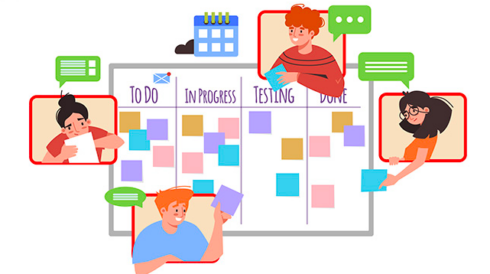
Twenty-two years ago, at a ski resort in Utah, 17 technology thought leaders came together and drafted an Agile Manifesto, a set of principles for a new approach to software development. Unlike the traditional “waterfall” approach that had been popular, this new approach would focus on iterative improvements and constant innovation.
Since that fateful night, this methodology has become a stronghold of software development. In Digital.ai’s most recent State of Agile report, 94% of respondents were practicing Agile, and 32% have been doing so for at least 5 years.
The original Agile Manifesto contained a list of four values:
- “Individuals and interactions over processes and tools
- Working software over comprehensive documentation
- Customer collaboration over contract negotiation
- Responding to change over following a plan”
In recent years, one of the biggest shifts in how companies practice Agile is, unsurprisingly, having to accommodate a whole new style of working. According to Digital.ai’s survey, only 3% said they planned to return to the office full time. 25% said they will remain fully remote and 56% will use a hybrid approach where people will be in the office some of the time, but not all.
“In last year’s survey we found fewer who are completely remote than planned, but still about half of respondents are mostly remote,” said Wing To, vice president of engineering for value stream delivery platform & DevOps at Digital.ai. “Expect some adjustments over the next few years as leaders try different approaches.”
According to Aaron Morris, owner of the educational platform agile-innovations.tech, the early days of Agile required teams to be located in the same place because there would need to be a daily stand-up meeting and a shared board to track sprints, which was often just a whiteboard on a wall.
“Since then, technology has advanced so much that distributed teams are no longer a big deal. Stand-up meetings happen over MS Teams or Zoom, and the team board is hosted in a shared cloud app like Jira,” said Morris. “I once worked on a team where our developers were distributed across Pennsylvania, Ohio, Illinois, Brazil, Turkey, and Russia…but we worked from the same sprint board and met every day at 10am Eastern.”
So, while the Agile Manifesto may favor “individuals and interactions over processes and tools,” tools have become quite a necessity to facilitate the communication and collaboration needed to do Agile correctly these days.
“Communication is important,” said Raveesh Dewan, CEO of Joget, an open-source low-code platform. “Not just verbal, but what you are doing in the tools is equally important.”
Dewan’s team is fully remote, so it’s absolutely crucial that everyone is providing updates into the tools so that everyone is on the same page and they can track progress. An example he gave is if there are 10 user stories on your plate and you have only finished five within the planned time frame, then you have a better sense of the actual velocity of the project.
“That’s pretty much it, there is no rocket science behind it, there is no mantra behind it that ‘thou shalt do it this way.’ It is just a matter of being disciplined and making sure that I have given my updates today,” he said.
According to Digital.ai’s survey, the most common types of tools that people use include Kanban boards, taskboards, spreadsheets, agile project management tools, bug trackers, and wikis.
Popular tools to use for Agile include Atlassian Jira, Azure DevOps, Broadcom Rally, Trello, and even just Google Docs. According to the survey, 48% of respondents are using Google Docs for Agile planning.
It’s also important to keep the people aspect front and center when working remotely. For example, Yemisi Iyilade, product management coach and educator, said that at her company there is a rule to always have your camera on. She believes there’s a lot of communication that happens just in your body language, and you would miss out on that if you were only communicating through voice.
“Even if your little child is there, it’s okay … because we understand that you are a person before your work,” she said.
Speaking on the importance of people, she also highlighted that it’s important that all employees feel appreciated and valued. This can be accomplished through regular one on one meetings.
Another thing many companies do to accomplish this is to provide flexibility around work hours. “Some companies now have a few hours in the day as mandatory hours,” she said. “This means that those are the only hours, maybe four hours out of the seven or eight hours, that you are mandated to be online. The other hours, you can spread it according to your own personal day.”
Agile moves beyond software development
While Agile was originally developed as a way to improve software development, it’s actually moving out of software development teams and all sorts of business teams are experimenting with and using Agile.
According to the Digital.ai survey, 86% of respondents used Agile in their software development teams. But 63% use it in IT, 29% use it in operations, 17% use it in marketing, 17% use it in security, 16% use it in human resources, 11% use it in sales, and 10% use it in finance. And 52% say that a majority of their company’s teams have adopted Agile.
Morris explained that for quite a long time, Agile was viewed suspiciously by business managers, especially in regulated industries. He recounted how when he was first starting out as a developer, he worked for a medical device company and his team spent six months persuading their manager to let them even try a few Scrum sprints.
“Now, agile development is a common practice in most industries,” he said. “And even in regulated industries—where waterfall development is still king—there’s a strong movement towards agile, and much fewer people view it with the same suspicion as 10+ years ago.”
Encourage a culture of failure
Another side effect of the COVID-19 pandemic is the need to be ready to innovate, always. This includes encouraging a culture of failure, according to Iyilade.
This doesn’t mean that you necessarily want things to fail, but that you want to be able to try new things without the fear of failure.
“The reality is innovation is saying ‘we don’t know how to do this. Let’s try. And we tried it, and this is what we got. And it’s okay. The next time we’ll do it better, doesn’t mean we failed. It means we’ve learned something new,’” she said.
As an example, Iyilade said to imagine a team that wants to develop a dashboard to view the status of a project or product. The first iteration may have a bit of risk associated with it, but by the second iteration, the team has learned from whatever went wrong on the first try and can do those things differently on the next go.
“We want to focus on the new learnings, the creative ideas that just came out, the new knowledge that came out,” she said.
The emergence of value stream management
Another methodology that has sprung up in the past few years that ties in nicely with Agile is value stream management.
According to Cameron van Orman, chief strategy officer at Planview, value stream management is important because it provides a holistic view of the whole value chain and can help identify areas that could be improved.
It can be used to help create a culture of transparency, break down silos, and align business goals.
“With a focus on delivering value to customers and shifting from project to product, the entire organization can work towards a common goal and align business objectives. As Agile continues evolving and gaining popularity, organizations must continuously refine their Agile practices to meet changing circumstances,” he said.
According to van Orman, newer Agile frameworks like the Scaled Agile Framework (SAFe) work well with value stream management too. He said that combined, they offer “a solid foundation for organizations to succeed in remote and hybrid environments.”
Low-code and Agile make a perfect pair
As mentioned earlier, the first value of the original Agile Manifesto of “individuals and interactions over processes and tools,” has sort of fallen off. Low-code is another example of this, as it really enables people to think in a more Agile way and promotes experimentation.
According to Dewan, the ability to quickly drag and drop components enables you to go faster and try more things out.
“Low-code takes it to a different level because it makes everything visual,” he said. “You can drag and drop while collaborating, while having the conversation, so cycles of iterations go faster.”
This iterative approach with low-code becomes even more powerful when combined with fusion teams: separate teams in the business working with IT. “It can quickly show them these are the options, and iterate through those options much faster than traditional application development,” said Dewan.






